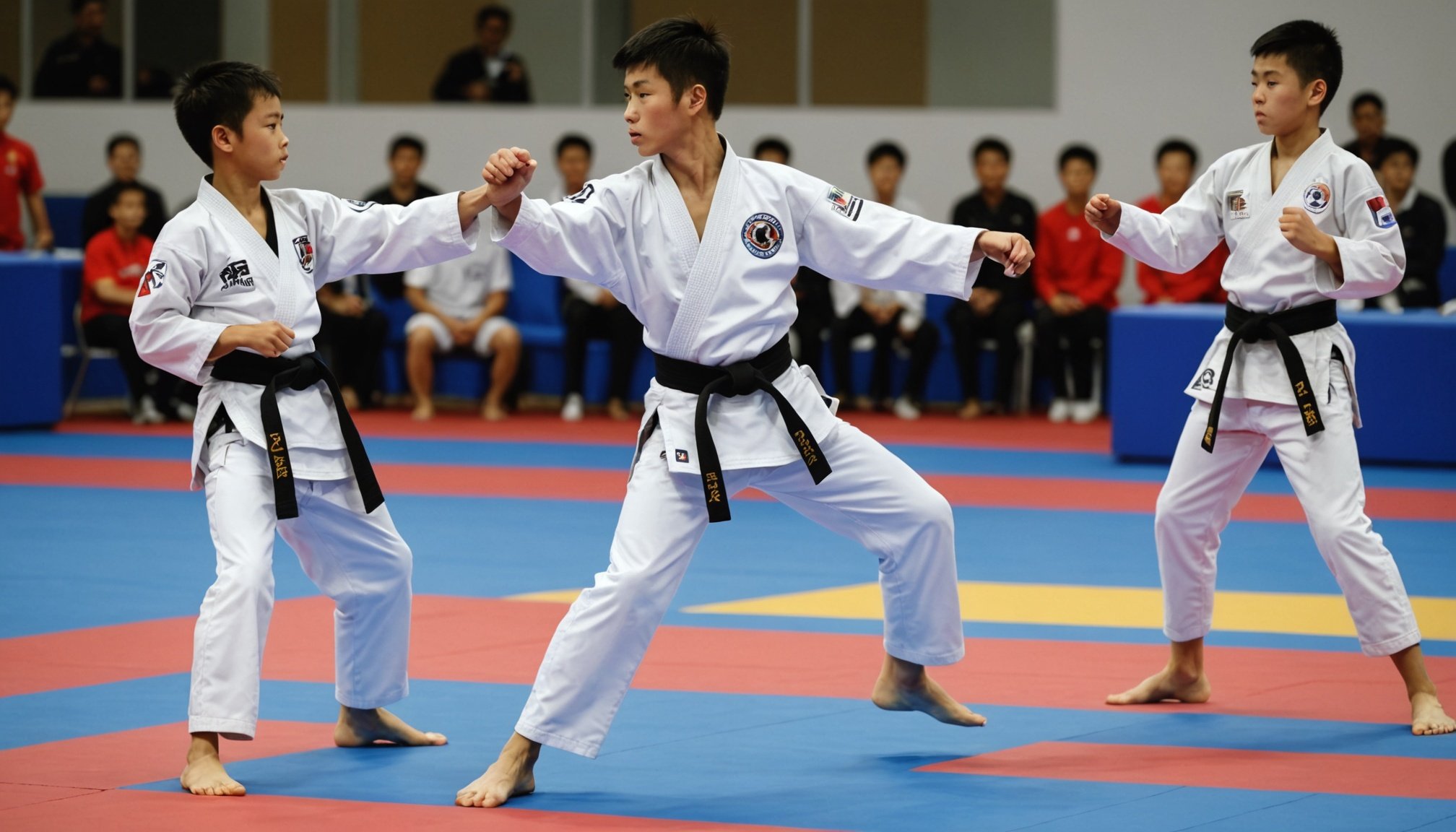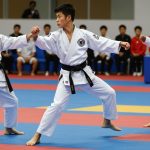Understanding the Goals of Junior National Taekwondo Training Programs
When it comes to junior athletes, setting clear, measurable goals within their training programs is crucial for success. Training program goals are essential to bridge individual aspirations and team objectives, fostering a cohesive and motivating environment. By aligning athletes’ goals with the broader goals of the training program, junior athletes can stay motivated and focused on their development.
Importance of Clear Goals
Taekwondo goals need to be well-defined to track progress effectively. This not only helps in personal development but also ensures that each athlete contributes towards the collective success of the team. Clear goals offer a roadmap to success, providing athletes with a sense of purpose and direction.
This might interest you : Discover the best pistol gel blasters for every adventure
Aligning Individual and Team Objectives
It is vital for junior athletes’ objectives to resonate with the team’s goals. This alignment can lead to improved teamwork, better communication, and an overall strengthened competitive edge. The synergy between personal and team aspirations boosts morale and performance.
Examples of Long-Term and Short-Term Goals
Some potential goals for junior athletes might include:
Additional reading : Exploring the Impact of Barometric Pressure Variations on Skydiving Performance
- Enhancing specific skills, such as speed and technique (short-term)
- Competing at a national championship level (long-term)
- Building physical endurance and mental resilience (long-term)
Setting these goals helps guide the athletes’ journey, leading to both personal and collective achievements.
Designing the Training Program Structure
In crafting a Taekwondo Training Program Structure, several key components must be prioritized to ensure success. A robust program design encompasses a well-rounded Taekwondo training framework, focusing on skill development, conditioning, and recovery. Each of these elements plays an integral role in an athlete’s progress and achievement in the sport.
An effective Taekwondo training framework includes a periodization strategy, which is essential for managing workload and preventing burnout. Periodization involves structuring training into phases, allowing practitioners to focus on specific goals at different times of the training cycle. This method ensures athletes can dedicate time to mastering techniques while gradually improving physical conditioning without overwhelming the body.
Balancing skill development and conditioning is crucial. Skill development focuses on fine-tuning techniques and improving the execution of moves, while conditioning enhances physical attributes like strength, endurance, and agility. Integrating both allows athletes to perform at their best during competitions.
Recovery is often overlooked but is equally important in a Training Program Structure. Scheduled rest days and recovery sessions are essential for muscle repair and adaptation, preventing injuries and ensuring long-term progress. By addressing these critical components, the Taekwondo training program can support the athlete’s growth and maintain their physical and mental well-being.
Developing Training Schedules and Routines
Creating effective training schedules and Taekwondo routines is essential for building skills and achieving goals in martial arts. Consistency is key to mastering techniques and improving performance, but it’s equally important to incorporate flexibility to adapt to individual needs and competition requirements.
Weekly Training Schedule
When designing a weekly training schedule, balance is crucial. Allocate time for different types of training such as forms, sparring, and conditioning. Include rest days to allow for recovery and maximise long-term progress. For instance, a typical week could comprise:
- Monday: Forms practice and light conditioning
- Tuesday: Sparring drills and strategy development
- Wednesday: Rest or yoga for flexibility
- Thursday: Intensive sparring and endurance
- Friday: Focused forms improvement
- Saturday: Mixed training sessions
- Sunday: Rest
Daily Training Routine
A well-structured daily training routine can enhance training consistency. Start with a warm-up, followed by skill drills, then move to a specific focus area for the day. Conclude with a cool-down session. Tailor drills to develop both strength and technique.
Adjusting Schedules for Competitions
Adapting training schedules for competitions is vital. Increase intensity in the weeks leading up, and focus on honing competitive strategies. Adjust routines to align with the competition’s demands while ensuring adequate rest and recovery.
Skill Development Activities for Junior Athletes
Skill development in Taekwondo is vital for junior athletes looking to excel in the sport. To ensure comprehensive growth, athletes should focus on core Taekwondo techniques, including basic kicks, punches, and blocks. Emphasising these foundational skills helps create a robust technical base.
Incorporating sparring, patterns, and drills into training can significantly boost an athlete’s technical prowess. Sparring hones reflexes and timing, while patterns, or “poomsae,” enhance memorisation and precision. Drills, on the other hand, are crucial for repetition and muscle memory, allowing athletes to perform complex movements effortlessly.
To facilitate maximum skill development, continuous monitoring and adjustment of drills are necessary. Coaches should regularly assess athletes’ progress and modify drills to target specific weaknesses or to increase difficulty as skills improve. This adaptive approach ensures that junior athletes are constantly challenged and stay engaged in their training regimen.
Tailoring the training to the athlete’s pace and development stage can foster a more productive learning environment. This structured plan, focusing on skill development, enables junior athletes to progress confidently and prepares them for competitive scenarios efficiently, laying a solid groundwork for their future in Taekwondo.
Physical Conditioning Guidelines
Physical conditioning is an essential component of enhancing athletic performance. It involves a comprehensive approach that includes cardio and endurance training, strength development exercises, and flexibility and injury prevention strategies.
Cardio and Endurance Training
Cardio and endurance training plays a vital role in improving physical conditioning. Activities such as running, cycling, and swimming are effective in building cardiovascular endurance. How can these activities be optimized for performance? Consistency and gradually increasing intensity are key. By focusing on progressive overload, athletes can boost their stamina and cardiovascular health, which is crucial for peak performance.
Strength Development Exercises
Strength development involves structured fitness training to increase muscle power and overall strength. What exercises are most effective? Compound workouts like squats, deadlifts, and bench presses not only enhance muscle strength but also improve functional fitness. Tailoring these exercises to meet the specific needs of junior athletes is essential, ensuring that they are age-appropriate and focus on developing foundational strength.
Flexibility and Injury Prevention
Flexibility is vital for reducing injury risks. Integrating stretching routines, such as dynamic and static stretches, can significantly aid in injury prevention strategies. Why is flexibility important? It enhances mobility and supports overall athletic performance by allowing greater freedom of movement and reducing muscle tension. Implementing these routines as part of a recovery strategy is vital for sustainable athlete development.
Nutritional Advice for Young Athletes
When it comes to sports nutrition for young athletes, understanding the right balance of nutrients is critical for optimal performance and health. A well-rounded Taekwondo diet, for example, should include a balance of carbohydrates for energy, proteins for muscle repair, and fats for sustained energy. Young athletes should aim to eat a variety of foods, including whole grains, lean proteins, and healthy fats like nuts and avocados to support their athlete wellness.
Hydration is another key component. Young athletes should drink water throughout the day and especially after engaging in strenuous activities. Dehydration can significantly impact performance and recovery, so carrying a water bottle to practice and filling it constantly is a good habit. In addition to water, drinks with electrolytes can be beneficial post-exercise.
Recovery nutrition is also vital. After training, a snack or meal that includes both protein and carbohydrates can replenish energy stores and promote muscle recovery.
Meal plans tailored for different training phases can guide young athletes. During intense training, including extra carbohydrates and proteins will fuel performance and recovery. Conversely, during off-season or less intense periods, focusing on maintaining a balanced intake without excessive carbohydrates is advisable.
Psychological Preparedness Tips
Being mentally prepared is just as fundamental as physical training for athletes. A strong sports psychology foundation can significantly enhance performance, especially for junior athletes.
Building Confidence and Resilience
Confidence for junior athletes is crucial but often elusive. Mentally training skills like positive self-talk and embracing challenges can reinforce self-assurance. Encouraging a growth mindset allows athletes to view setbacks as opportunities for learning rather than failures. Coaches and athletes should consider incorporating regular mental practice sessions to bolster these qualities.
Visualization and Mental Imagery Techniques
Visualization is a proven technique in sports psychology. Athletes can mentally rehearse their skills, imagining successful performances and critical moments in vivid detail. This technique not only prepares the mind for action but also aids in muscle memory development. It’s an empowering tool that athletes can use before events to enhance focus and composure.
Stress Management Strategies
Stress can hinder performance; hence managing it is vital. Techniques like deep breathing, mindfulness, and cultivating a positive mindset can significantly reduce anxiety levels. Incorporating these mental training methods into daily practice helps athletes stay calm under pressure. Coaches can offer resources and workshops to support athletes in utilising these strategies effectively, ensuring mental resilience is part of their training regime.
Insights from Experts and Best Practices
Gaining insights from seasoned professionals is invaluable for those seeking to implement the most effective training best practices in junior taekwondo programs. Interviews with experienced coaches and trainers reveal a multitude of strategies that contribute to successful athlete development. One prominent coach emphasised the importance of tailoring training plans to meet each student’s individual needs, noting that “understanding the unique strengths and weaknesses of each athlete is crucial.”
In analysing successful junior taekwondo programs, expert opinions highlight the significance of not only physical conditioning but also mental preparation. Incorporating sessions focused on mental resilience can enhance training effectiveness dramatically. Coaches recommend dedicating time to teach visualization techniques and techniques for managing stress during competitions.
Key takeaways from expert practitioners suggest incorporating diverse training methods, such as combining technical drills with sparring sessions, to maintain engagement and improve adaptability. Furthermore, seasoned coaches underscore the value of creating an inclusive and supportive environment. This encourages young athletes to remain committed and fosters a sense of camaraderie.
Ultimately, integrating these insights and best practices can help trainers elevate their programs and support athletes in reaching their full potential in taekwondo.
Resources for Further Reading and Planning Templates
Exploring Taekwondo Literature can significantly enhance your understanding of the sport. Recommended books and articles provide in-depth insights into techniques and philosophies. “The Anatomy of Martial Arts” stands out, covering biomechanics and injury prevention effectively. For more strategic learning, “Tae Kwon Do: The Ultimate Reference Guide to the World’s Most Popular Martial Art” offers a comprehensive overview.
Coaches and athletes often benefit from curated Training Resources. These resources include online platforms with instructional videos, podcasts, and interviews with prominent taekwondo figures. The World Taekwondo Federation regularly updates these resources, making them an excellent source for the latest techniques and regulations.
Innovatively designed Planning Templates serve as indispensable tools. Such templates assist in devising well-structured training plans and maintaining session logs. Training plans are typically crafted to track progress, manage goals, and ensure consistency. These templates often come pre-filled with examples, providing a structured starting point for individual modifications.
It’s crucial to integrate these resources and templates into your routine. Doing so can elevate training efficacy, providing both theoretical knowledge and practical application. This comprehensive approach enhances skill development and strategic planning, fostering a deeper connection with the sport.











